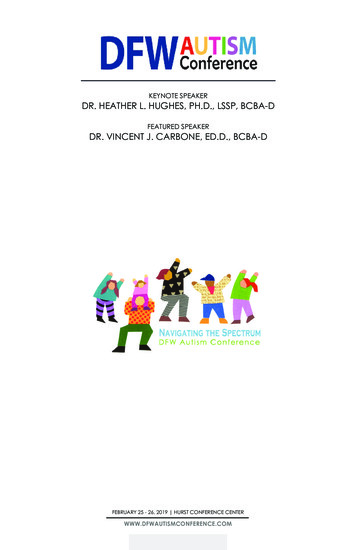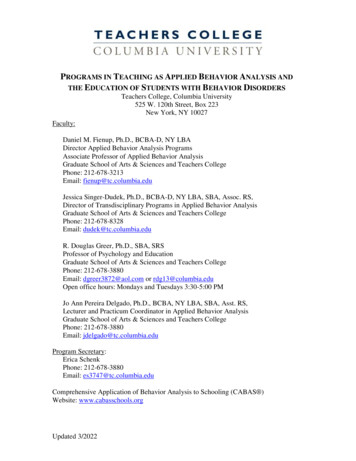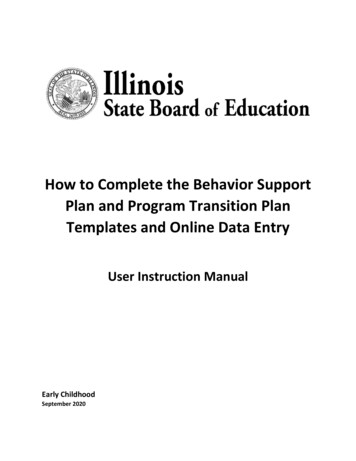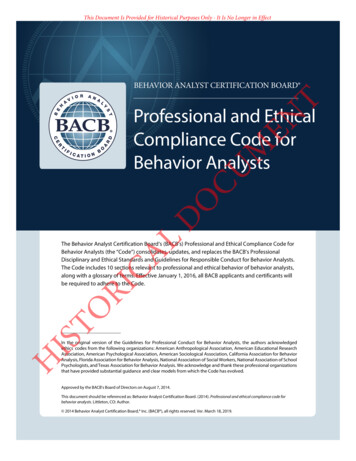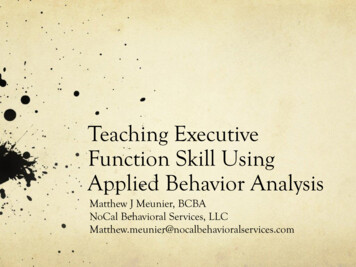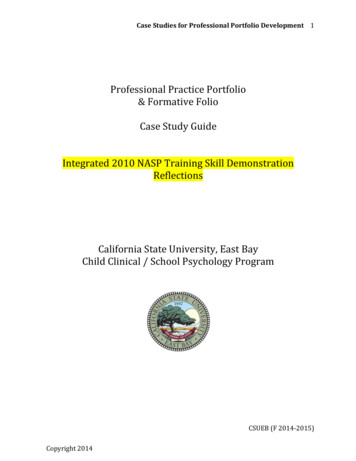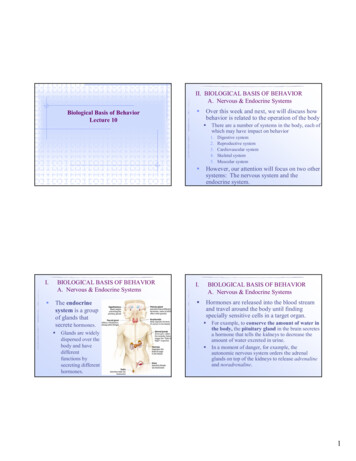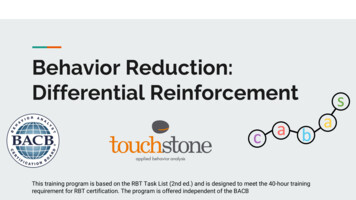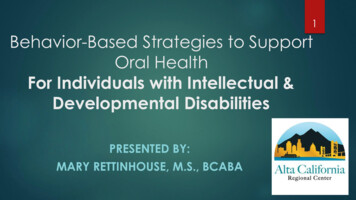
Transcription
1Behavior-Based Strategies to SupportOral HealthFor Individuals with Intellectual &Developmental DisabilitiesPRESENTED BY:MARY RETTINHOUSE, M.S., BCABA
2Before We Get Started The presenters have no relevant financial relationship withthe manufacturer(s) or any commercial product(s) and/orprovider of commercial products or services discussed inthis presentation
Going to the Dentist:The Patient ExperienceIdeally it goes like this .3but sometimes it’s like this
Why do so many people dread going to the dentist?4 60% of people have anxiety about going to the dentist (www.ada.com) 5-10% have “dental phobia”www.studyfinds.org
Additional Considerations for Individualswith Developmental Disabilities (DD) Difficulty interpreting environment from existing cues(what is going to happen next?) Schedule/routine rigidity; insistence on sameness Communication differences- expressing wants andneeds Sensory sensitivities Ability to self-regulate when anxious or stressed Challenging behaviors (self-injury, aggression,hyperactivity etc.)5
TheResults In a study assessing the oral healthof 4,732 individuals withdevelopmental/intellectualdisabilities: 88% experienced toothdecay/cavities32.2% had untreated dentaldecay/cavities10.9% were lacking teethApproximately 25% requiredbehavior managementinterventions (including generalanesthesia) to access dentalintervention(Morgan, Minihan, et, al., 2012)6
Most Common Barriers ImpactingDental Care/TreatmentBarriers ImpactingDental CareBarriers ImpactingOral Health Limitations in performingdaily oral care routines(i.e., cognitive, physical,behavioral) Medication side effects Consent (client rights) Challenging BehaviorsCostLack of insuranceScarcity of dental providersavailableConsent(Lai, Milano, Roberts & Hooper, 2012)7
So then, how do we get more8patients with DD to experiencedental visits like this?
Taking an Evidence-Based ApproachWhat is an Evidence-Based Practice? Interventions that have been scientifically proven to beeffective Identified through analyzing ONLY high-quality researchstudies Produce desirable effects Can be used individually or in combinationEBPs THINGS THAT WORK!Adapted from: (Embry, 2004)9
How do we know what works for teaching10skills & managing problem behaviors forindividuals with developmentaldisabilities?Adaptive SkillsProblem Behavior
National Clearinghouse on AutismEvidence & Practices11 Published a new report in 2020 evaluating interventionresearch between 1990 and 2017 Details 28 Evidence-Based Practices for both skills teachingand/or behavior reduction Provides FREE online video training modules on most of thepractices
28 Evidence Based Practices- NCAEP (2020)Antecedent Based InterventionAugmentative & AlternativeCommunicationBehavioral Momentum InterventionCognitive Behavioral InterventionDifferential ReinforcementDirect InstructionDiscrete Trial TeachingExerciseExtinctionFunctional Behavior AssessmentFunctional Communication TrainingModelingMusic Mediated InterventionNaturalistic InterventionParent-Implemented InterventionPeer-Mediated Instruction andInterventionPromptingReinforcementResponse Interruption/RedirectionSelf ManagementSensory IntegrationSocial NarrativesSocial Skills TrainingTask AnalysisTechnology-Aided Instruction andInterventionTime DelayVideo ModelingVisual Supports12PLUS- A set ofManualized Programs: Picture ExchangeCommunicationSystem Pivotal ResponseTraining JASPER Milieu Training PEERS Project Impact Social Stories Stepping Stones Mindreading FaceSay
Using These Strategies for DentalAppointments: Antecedent-Based Interventions Modeling & Video Modeling Reinforcement Social Narratives Visual Supports13
Antecedent-Based Interventions(things to do before the dental exam) Be strategic about appointment times (for office andindividual) Break up the initial appointment into several parts Keep the individual’s daily schedule “light” Encourage use of additional support (an extra person) Have sensory blocking and/or comfort items available Priming(the dental treatment process and reinforcement)14
Make the Dental Visit More Enjoyable!Ask if dental office provides fun activities that canbe incorporated into the visit (video games in lobby,movies in ceiling etc.) Ask dentist to use a “tell, show, do” method forcommunicating during visits Ask if dentist offers or allows for accommodationssuch as noise cancelling headphones, sunglasses,lower lighting etc. Take time to share with the dentist about theindividual’s specific needs (complete a pre-visitquestionnaire) 15
Modeling/ Pretend Play “Dentist”In preparation for the dental visits, pretend-play/ role-play“Dentist” activitySteps to Make Modeling Successful:1.2.3.4.5.6.Gather materials (pretend dental tools, mask etc.)Develop your “script”Determine a good time & placeKeep practice sessions short to startDetermine how to rewardTake turns being both “patient”& Dentist16
Video Modeling17In preparation for dental visits, the individual is shown a videodepiction of another person going through the steps of a dentalappointmentHow to Create a Video Model1.Plan your location, materials andscript2.Pick up your smartphone, tabletor camera3.Make the video4.Show the individual the video5.Review the key concepts6.Provide an opportunity for theindividual to practice7.Prompt and reinforce as neededLook At Me Now- Personalized Self Video Models
Planning for ReinforcementIndividual is provided a desired item/object/activityfollowing the completion of the pre-determinedtask/activityHow to Use Reinforcement Effectively:1.Determine both the CRITERIA to obtainthe reward as well as WHAT the rewardshould be2.Have a variety of options/choicesavailable (prize box, treasure box)3.Deliver the reward only after the task iscomplete18
Social NarrativesVisual depiction of social situations that provides relevant cues and describesexpectations of appropriate behavior19Social Stories - Most well-known, developed by Carol Gray, descriptionof a social situation and appropriate behaviorsFor links to 12 different FREE pre-made social stories go to www.pathfindersforautism.org
Steps for Using Social Narratives201.Introduce the Social Narrative to the individual2.Individual reads Social Narrative (or has it read to him/her)3.Individual participates in identified social situation (ormock situation)4.Review key concepts with individual5.Provide prompts and reinforcement as needed
Visual Supports for Use to SupportDental VisitsVisual TimersHow I’m Feeling:21
22Strategies to Support Daily OralHygiene Practices at Home
Visual SupportsPicture of steps for tooth brushingposted above bathroom sink,list/picture schedule that includestooth brushing and flossing, etc.23
Reinforcement Make activity more funby using materials thatthe individual enjoys(favorite color, characteretc.) Parent/caregiver givespraise, toy, etc. whenindividual completestooth-brushing routine24
Modeling & Video Modeling25Individual watches a live person or video of someone tooth brushing and/or flossing priorto completing the tasks (teaching your-teeth/
Using TechnologyThere are a variety of games,applications, audio books,videos, music and moreavailable online to makeusing these techniques easy,fun and interesting!Fun Fact- TechnologyAided Instruction isanother EBP!26
Using Technology- Smart k27
Additional Considerations Behavior change may not be quickSmall steps may be necessary to shape the behavior anddesired outcome Consult and seek the support of a qualified professional (BCBA) Collaborate and communicate with all professionals involved in theprocess Strive for consistency in intervention/treatment implementation Educate yourself on options Determine if the individual has the pre-requisite skills needed toparticipate in a dental visit (remaining seated, responding tosingle-step instructions, allows others to touch etc.) Developmental age of 29 months (B. Rud, E. Kisling, 1973)28
Putting It Into Action!29Everyone will receive access to an electronic folder ofresources which include:- Strategy Selection Tool- Patient Support Needs Questionnaire- Visual Supports (First/Then, Picture Activity Schedule,brushing teeth mini schedule)- Sample Social Stories- Sample Video Models- Autism Speaks Dental Tool Kithttps://drive.google.com/open?id 1x0dF9lUvUBI uiu3J g1bF2vuGP-k1eg
30
Resources Alta California Regional Center31 2241 Harvard Street, Suite 100Sacramento CA 95815California Autism Professional Training andInformation Network (CAPTAIN)https://www.captain.ca.gov(916) 978-6400https://www.altaregional.org/ Autism Speaks Dental l-tool-kitAmerican Dental Association (ADA)http://www.ada.org/en Department of Health Care lgate Dental Hygiene ClassroomMaterials & Curriculum for s-bright-futures/program-materials/for-teachers
References for this PresentationMorgan, Minihan, Stark, Finkelman, Yantsides, Park, Nobles, Tao & Must (2012). The Oral Health Status of 4,732 Adultswith Intellectual and Developmental Disabilities. Journal of the American Dental Association, (143) 838846.Lai, B., Milano, M., Roberts, M., & Hooper, S. (2012). Unmet Dental Needs and Barriers to Dental Care among Childrenwith Autism Spectrum Disorder. Journal of Autism and Developmental Disorders, (42) 1294-1303.Lyons, Ray A. (2009). Understanding basic behavioral support techniques as an alternative to sedation andanesthesia.Special Care Dentist 29(1): 39-50.Cooper, John O., Heron, Timothy E. & Heward, William L. (2007). Applied Behavior Analysis, Second Edition. UpperSaddle River, New Jersey: Pearson Education, Inc.Smith, Tristram (2013). What is Evidence-Based Behavior Analysis? The Behavior Analyst, (36) 7-33.Lydon, S., Healy, O., O’Callaghan, O., Mulhern, T., & Holloway, J. (2015). A Systematic Review of the Treatment of Fearsand Phobias Among Children with Autism Spectrum Disorders. Journal of Autism and DevelopmentalDisorders, (2) 141-154.Orellana, L., Martinez-Sanchis, S. & Silvestre, E. (2014). Training Adults and Children with an Autism Spectrum Disorder tobe Compliant with a Clinical Dental Assessment Using TEACHH-Based Approach. Journal of Autism andDevelopmental Disorders, (44) 776-785.32
Strive for consistency in intervention/treatment implementation Educate yourself on options Determine if the individual has the pre-requisite skills needed to participate in a dental visit (remaining seated, responding to single-step instructions, allows others to touch etc.) Developmental age of 29 months (B. Rud, E. Kisling .


